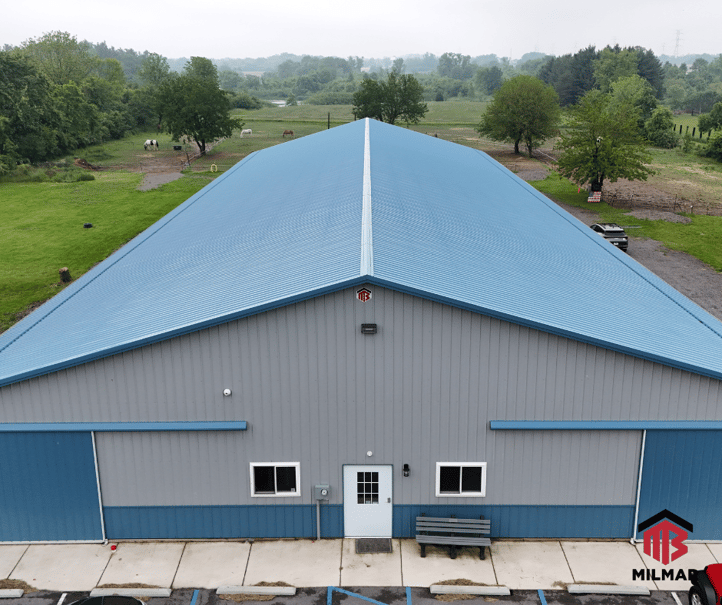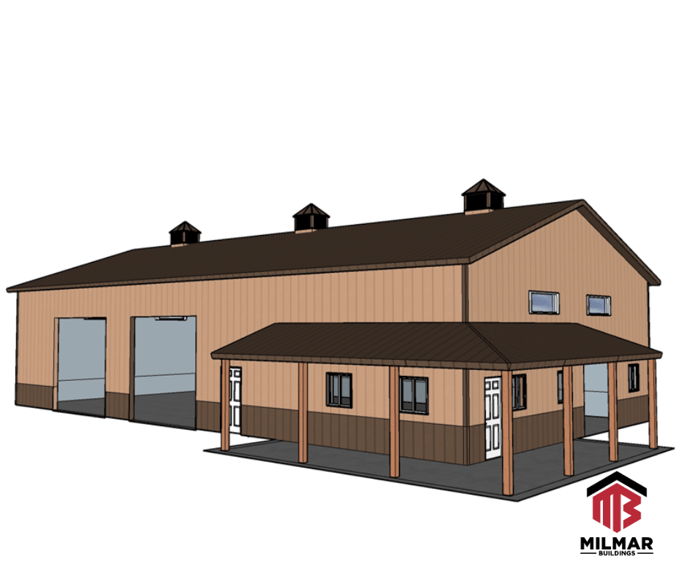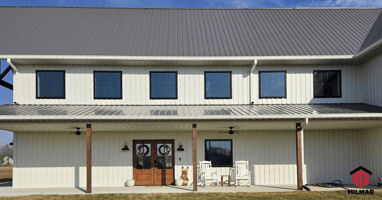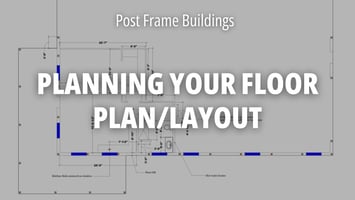Why Do Pole Barns Cost More Than They Used To?

Pole barns began as a relatively cheap option for ag buildings back when they first began. We won't get into an extensive history of pole barns here, but basically during depression-era times, farmers needed cheap options that would work for cost-effective (albeit somewhat limited) and time-efficient builds that could be pieced together. Originally, they were typically constructed with leftover or old telephone poles. Hence, the moniker pole barns.
Pole barns, post frame buildings, metal barns, metal buildings, or pole buildings. Whatever you or your area of the US calls it, they are popular right now and there is sometimes controversy surrounding the pricing of them!

A few reasons people think they should cost less than they do (when you are building with an experienced, professional builder) is because they'll see others say things like "mine only cost X amount to build - start to finish!" and similar things. The tough thing about comparisons are that they are often not apples-to-apples. The best way to get apples-to-apples comparison of quotes and pricing is to figure out the build YOU want or need, then take idea or plan to multiple builders and have them quote you for the exact same build. Some things that impact pricing include the features you want included in your build, your location (yes, location can drive up costs. Builds in San Francisco, CA are more expensive than ones in the middle of a township in Kansas), and the experience and reputation of the builder you are working with.
Post frame construction is quicker to build than traditional construction methods, easier to maintain, and can be still be more economical than traditional construction methods, if the right building options are chosen.
While a nice, cheap build would be awesome for everyone who wants a pole barn, with the cost of new construction, land, septic, driveway, etc., it can get out of hand (and budget) quickly if you aren't careful.
If you ask people online what you can expect to get on a tighter budget, unfortunately some of the responses will be jokes about buying a yard shed or complaints about how much it costs to build and how you just can’t make it work. Some will say that you can build for super cheap, which while there are some self-build kits that are available at a lower cost than having a team come in and build your barn, there are pros and cons to every method for your build.
So, does that mean you have to give up on your dream of building your barn, garage, or outbuilding? Absolutely not!
Let's look at a few things including
1. Current building costs/some of the reasons for higher costs in recent years.
Staying Informed on Building Costs
Something to keep in mind is that the cost to build any building in 2016 was significantly different than it is in 2025. Think of home costs in 2016 vs home costs today, and that alone will tell you the vast difference in costs for building.
The average cost of a new build has significantly increased, even in the last couple years the change has been noticeable (see the difference between 2022 and 2024 new home costs according to the NAHB - page 3 of each of these reports is especially telling). This doesn't mean you can't build! These are just tools and information that show the difference in building costs, to help you as you plan and to take a peek at some more realistic reasons why costs have increased.
Costs that not everyone thinks of when starting to plan their build
If you look at new build costs in Kansas vs in Hawaii, they are going to be staggeringly different. But this can even vary based on what area of a state you're in. Costs to develop land is another factor that will vary greatly based on your location. Cost for utilities such as water/well digging, septic and more (if any of these are needed or if there isn't an existing house on the property that would already have these types of things available) will vary based on the topography and what's underneath the top layer of soil.
Site prep is another variable. If your desired location to have your build constructed is already at a pretty level area on your property, and doesn't have a bunch of trees or brush to remove, it will likely be an "ideal" location for less expensive site prep work. If you have a bunch of trees that need cleared, stumps ground out, ground leveled, a retaining wall installed, or rougher/less even terrain in general, then your site prep costs will increase accordingly. We have seen many customers take on doing some of the site prep work themselves to save on costs.

Milmar Building Shells
The price for a building shell with Milmar and some of the most common add-ons can include any of the following that you request (this will vary in options, pricing, and what's included in the shell from builder to builder):
- Materials and labor to complete exterior dried-in shell
- Foundation
- Windows and door package (there can be a lot of change here based on whether you're going with standard or specialty/custom windows and doors)
- Drip-Stop condensation control on roof
- House wrap under wall steel
- Insulation/interior liner package
- Post Protector sleeves and/or perma-columns
- Grade guards/rodent guards on full foundation
- Porches/Lean-tos
- Cupolas
- Additional concrete for aprons, porches, patio areas, or driveways
The sky’s the limit when it comes to customizing your post frame building. Just remember, some things that tend to drive prices up quickly are the following:
- Perma-columns (awesome product, and great for ensuring a long-lasting build, but can be pretty pricey. We really encourage these for post frame homes or commercial builds especially, due to the level of use, and the added durability it offers)
- Post Protector sleeves (another great, but more reasonably priced product for protecting your posts from damage and rot)
- 2nd story/joists and floor systems
- Specialty doors and windows
- High end exterior finishes such as Hardi-Board, cedar or stonework
- Timber framed porches
- Dormers or more complex roof structures
- Decks
- High pitched roofs or attic trusses
- Standing seam roof (Great product, but adds to the cost)
- Hard to build lot/steep hill/drop off
- Large, elaborate porches
- In-Floor Heating (Radiant Heat)
Just a reminder that we have this helpful article How Much Does a Post Frame Building Cost for a more specific dollar range breakdown of a lot of these, and of the basic costs too.
All this to say, the best ways to keep your cost down on a new building is:
- Keeping the overall design simpler
- Self finishing/directing your interior build-out and finishes if you have the skill level to manage it or do some of the work yourself
- Prioritizing what's most important to you in the build, instead of trying to include every feature you've ever seen ;)
Some other things that can impact costs are general economy-driven things. We have all seen prices rise across the board for everything in the US economy since 2019/the year of covid. Things like tariffs (like we're seeing now), market crashes, poor economy in general (think 2008), wars starting (even when the US is not as involved, this can impact costs of things in a variety of ways), and other politically generated disruptions.
When Planning Your Build
For buildings that you don't have an unlimited budget for (which most of us DO have a budget to stick to) we are fans of a suggestion from The Barndominium Company. They call it their three-sheet rule. Sit down and go over all your dream list items for your build, put that all on one sheet. Then go over your must-haves, the features you feel like are most important and order them from most important to you to least important to you.
Create a second sheet that includes your ideal build but with just your top one or two luxury features (maybe you decide that heated flooring is more important to you than custom cupolas and that custom window design, etc.)
Then create a third sheet that includes just the minimum of what would be acceptable for you, leaving off the "extra" items and going basic. These are the sheets then that you can share with your designer or builder and tell them where you need to be budget-wise. This will help inform them on what is most important to you to have included and they'll be able to help you out with the possibilities you have (realistically) with the budget you're working with.
This helpful thought can help you clear through the noise of some of the planning process and focus on what matters most to you.

Financing for Pole Barns
Financing for pole barns has become increasingly easier as the market has gotten more familiar with these buildings and as they have seen them used for broader use than just barns - now that post frame construction is used for many residential builds, homes, and commercial/business. We have a couple of financial organizations that have worked specifically with post-frame barns in the past and that encourage those seeking financing for a barn to start with them, but there are many lenders outside of these with which you can pursue financing for your dream garage, barn, or outbuilding.
There will be questions you have to answer, just like you would for any build loan, but these are becoming more and more standardized and typical as lenders have become more familiar with the construction process of post-frame builds. We're happy to help provide you with any helpful info and resources as you navigate the financing process for your project with Milmar.
We are here to help you succeed and are always working on putting out information here on our web page so you can learn more about post frame construction, know that you are asking the right questions, and are informed as you plan out your shop, garage, or barn!
You can contact our team with questions or to get started on planning or building your project.




